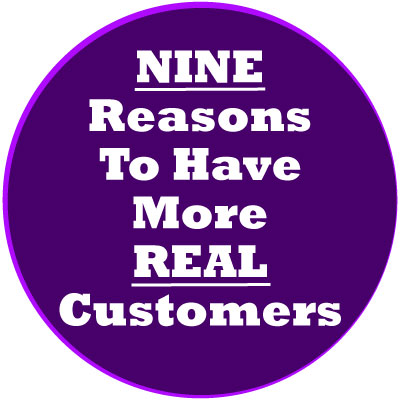 No, this is not a joke title. One of our prospective clients recently asked me how many “real” customers he needed.
No, this is not a joke title. One of our prospective clients recently asked me how many “real” customers he needed.
He asked me this question as he was familiar with the Federal Trade Commission’s actions against Vemma in 2015 and Herbalife in 2016, each of which required sufficient volume from customers who were not representatives before multilevel compensation could be paid.
In the FTC action against Vemma, the customer volume requirement was 50% of the volume of downline IBOs while in the FTC action against Herbalife, the customer volume requirement was 66% of the volume of downline IBOs.
If you have 25 minutes available to learn the details of these two FTC orders, watch my Vemma and Herbalife video.
What Are Real Customers?
In the eyes of the FTC, a “real” customer is a consumer who is not pursuing a business opportunity. The Herbalife order identified two such classes of people:
- retail customers who simply buy products from Herbalife distributors and do not have any direct connection to the company
- preferred customers who have registered with Herbalife as customers and do not participate in the business opportunity
Under this order, there were a number of requirements that were intended to ensure that preferred customers represented a genuine class of discount buyers and were not simply business opportunity participants under another name. For example, under the order, preferred customers were not permitted to resell products, recruit, or receive multi‐level compensation.
Having Enough Real Customers
There was a time in the recent past when network marketing companies sold most of their products to their independent representatives for their personal use, and this was not a problem. Back then, they didn’t worry about acquiring customers who were not representatives.
The U.S. Direct Selling Association had lobbied hard to include in their definition of “ultimate consumer purchases” the purchases by independent representatives for personal use in reasonable quantities. A few legal cases against bad actors included mention of insufficient customer purchase activities, but there were no definitive cases that hit this nail straight on.
Even so, I started to worry out loud. In 2014, I wrote a prophetic post about the lack of retail customers. Then, in 2015 the Federal Trade Commission sued Vemma and in 2016, it imposed a settlement requiring that Herbalife restructure its business. Both actions were taken in part due to concerns over a lack of customers who were not representatives.
Today, direct selling companies whose sales are made primarily to their independent representatives may be at risk of similar FTC actions due to a lack of customers who are not representatives. The operative words are “maybe” because while the FTC’s measurements for sufficient “real” customers may be used again in future FTC actions or in future regulations, the reality is that the future is yet to be written.
If you’re thinking “better safe than sorry”, then ignoring the Vemma and Herbalife FTC orders isn’t appropriate.
What Will Please Big Brother?
Unfortunately (or fortunately, depending on your perspective), there is no formula anywhere that will please federal or state regulators because each of the actions against Vemma and Herbalife was specifically targeted at the respective company. The compensation plan restrictions imposed upon each of these companies apply ONLY to them.
There is no regulation in effect today at the federal or state level that mandates having customers who are not representatives. So, that is why there is no formula.
Now, What?
If you wish to be proactive and prepare for a likely future in which there may be regulations or FTC orders that will apply to you, the more volume generated by “real” customers you have (customers who are not representatives), the better.
Count Volume, Not Customers
It is interesting that many people ask about how many customers they need to have when instead they should be asking, “How much of my company volume needs to come from customer purchases?”
Seriously, it is not the count of customers that matters, but instead, the volume generated by them as a percentage of total company volume.
If your average “real” customer spends less on your products or services than the average representative, you would need more of them to generate sufficient total volume than if your average “real” customer had the same spending habits as your average representative.
What To Do About This
Here are my recommended strategies for direct selling companies to have more real customers:
- Don’t encourage people to join your company as independent representatives just for product discounts.
- Charge an enrollment fee high enough to be a representative that people don’t become representatives just for product discounts, but be sure not to pay any compensation upon the required fee.
- Don’t charge zero to be an independent representative with your company.
- Sell products or services that people will buy even if they are not earning any money through your compensation plan.
- Charge customers a reasonable price for your products or services.
- The price could be the same as the representative price, or it could be higher.
- Have a fully developed pricing strategy that addresses how to price for representatives and customers.
- Use sticks or carrots to increase customer sales.
- Be careful in how you incentivize sales to customers over sales to representatives or vice versa.
Conclusion
There is no specific number of customers that direct selling companies or individual representatives of direct selling companies must have to be legally compliant.
If you wish to comply with the FTC’s concerns over a lack of “real” customers, remember that what matters is the percentage of company volume that is generated from purchases by documented customers of your representatives and/or by customers who are participants in your income opportunity.

 Jay Leisner, the President of Sylvina Consulting, is a top compensation plan and direct selling expert, a trusted adviser to new and established network marketing and party plan companies. For more than 30 years, Jay has enjoyed assessing and improving network marketing, party plan and referral marketing companies across the globe.
Jay Leisner, the President of Sylvina Consulting, is a top compensation plan and direct selling expert, a trusted adviser to new and established network marketing and party plan companies. For more than 30 years, Jay has enjoyed assessing and improving network marketing, party plan and referral marketing companies across the globe.
Leave a Reply